
hotline:
17715390137
Tel/Wechat:
18101240246 (Technology)
0512-68565571
Email:mxenes@163.com (Sales Engineer)bkxc.bonnie@gmail.com
Scan the code to follow or search the official account on WeChat:
2D Materials Fronrier After paying attention,
click on the lower right corner to contact us,
Enter enterprise WeChat.
Professional Services Online

Research Background
The flexible strain sensor is of great significance in wearable electronic products because it can monitor physical signals from the human body. In order to meet the needs of practical applications, these strain sensors need to have high sensitivity, wide working range and adhesion to human skin. Among various strain sensors, foam sensors can not only detect tensile strain, but also compressive strain and torsional strain. In addition, it has received widespread attention because of its breathability, light weight, high flexibility and high stretchability. Although the sensitivity and sensing range of foam strain sensors have been improved through a variety of strategies, there are still huge challenges in developing high-performance wearable strain sensors with a wider working range and higher sensitivity.
Full text guide
In order to solve the above problems, the team of Academician Huang Wei of Nanjing University of Technology prepared a lightweight composite foam by adsorbing MXene nanosheets to the surface of multi-walled carbon nanotube (MWCNT) and thermoplastic polyurethane (TPU) composite foam prepared by the salt template method. And sensitive high-performance strain sensor. The TPU/MWCNTs@MXene sensor can provide a wide working strain range of ~100% and an excellent sensitivity of up to 363, which is better than the most advanced foam-type strain sensor. In addition, the syntactic foam exhibits excellent air permeability and a suitable elastic modulus close to the skin, indicating that it has a high degree of comfort as a wearable sensor. Due to these advantages, the sensor can effectively detect subtle/large human movements, such as joint movement, finger movement, and vocal cord vibration. In addition, the sensor can also be used for gesture recognition, indicating its application prospects in human-computer interaction. The results of the related papers titled "High-Performance Foam-Shaped Strain Sensor Based on Carbon Nanotubes and Ti3C2Tx MXene for the Monitoring of Human Activities" were published on ACS NANO on June 4, 2021.
The introduction is as follows:
1. Preparation of TPU/MWCNTs@MXene foam strain sensor
The TPU/MWCNTs@MXene foam strain sensor is prepared by a simple salt template and dip coating method (Figure 1). First, MWCNTs and TPU are mixed, and then salt particles are added as a template to form a porous structure. After removing the salt template in the water, the conductive TPU/MWCNTs foam is obtained, and finally it is soaked in the MXene suspension to obtain the final product. As the conductive MXene sheet is filled, the conductivity of the foam is further improved. When this TPU/MWCNTs@MXene foam is stretched, the conductivity of the foam decreases due to separation and sliding between conductive materials. Therefore, this TPU/MWCNTs@MXene foam can be used as a strain sensor.

Figure 1: The preparation flow chart of TPU/MWCNTs@MXene foam strain sensor.
2. Performance of TPU/MWCNTs@MXene foam strain sensor
From the XRD spectrum of the TPU/MWCNTs@MXene foam (Figure 2a), it is obvious that all the diffraction peaks of MXene are present in the TPU/MWCNTs@MXene foam. In the FTIR spectrum, the characteristic absorption peak of TPU can be clearly identified (Figure 2b). In the Raman spectrum, the peaks at 255.4, 453.0 and 621.9 cm-1 correspond to the Alg and Eg vibrations of Ti3C2F2 and the vibrations of Ti3C2(OH)2, indicating the existence of MXene. In addition, the D band (1372.8 cm-1) and G band (1600.7 cm-1) of MWCNTs also appeared in the Raman spectrum (Figure 2c, d). The SEM images of the TPU/MWCNTs@MXene foam also show that the MXene sheet is successfully attached to the TPU/MWCNTs foam (Figure 2e-g). And as the soaking time increases, more MXene sheets will be adsorbed.

Figure 2: (a) XRD, (b) FTIR and (c) Raman spectra of TPU/MWCNTs@MXene, TPU/MWCNTs and MXene. (d) Raman spectrum of a partially enlarged area. SEM images of TPU/MWCNTs@MXene foam prepared with different immersion times (e) 10, (f) 30 and (g) 50 minutes.
TPU/MWCNTs@MXene foam has high flexibility and stretchability, light weight and easy processing. Compared with pure TPU foam, TPU/MWCNTs and TPU/MWCNTs@MXene foam have higher elastic modulus and tensile breaking strength (Figure 3a). The Youngs modulus of TPU/MWCNTs@MXene foam is 140 kPa, which is close to the Youngs modulus of skin (25-220 kPa), indicating that the foam has high comfort as a wearable device on human skin. By putting the foam on the leaf, it shows that it has an extremely light weight (Figure 3b). Foam can also be easily cut into various shapes, such as hearts, stars, triangles and flower shapes (Figure 3c). In addition, TPU/MWCNTs@MXene foam can also be bent, twisted or knotted without damage (Figure 3d).
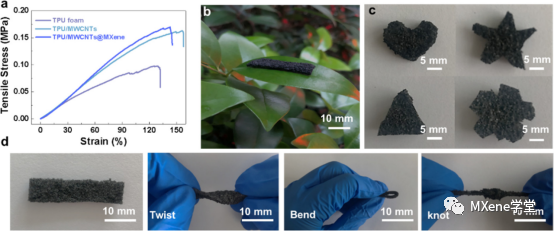
Figure 3: Mechanical properties and flexibility of TPU/MWCNTs@MXene foam. (a) The stress-strain curves of the three foams. (b) The lightness of TPU/MWCNTs@MXene. (c) Conductive TPU/MWCNTs@MXene foam of different shapes. (d) TPU/MWCNTs@MXene foam twists, bends and knots.
Due to the porous structure inside, the foam of this material has high air permeability. The permeability of the foam is determined by the water vapor transmission rate (WVTR), and the rate at which water evaporates through the foam indicates their permeability (Figure 4a). Obviously, due to the porous structure in the foam, the WVTR of TPU/MWCNTs and TPU/MWCNTs@MXene foam is much higher than that of TPU and TPU/MWCNTs film (4b). TPU/MWCNTs@MXene foam has a WVTR value close to that of human skin. Human skin can breathe normally during use, reducing the possibility of skin irritation.
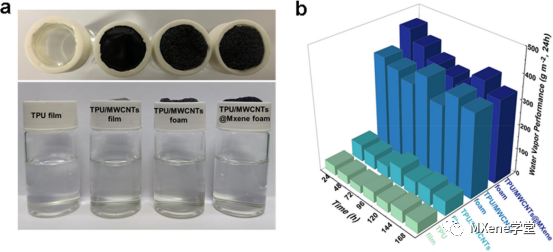
Figure 4: Air permeability of TPU/MWCNTs@MXene foam. (a) Photograph of the device used to measure the air permeability of TPU film, TPU/MWCNTs film, TPU/MWCNTs foam and TPU/MWCNTs@MXene foam. (b) Comparison of gas permeability of different samples at different times.
Figure 5a shows the relative resistance changes of TPU/MWCNTs, TPU/MXene and TPU/MWCNTs@MXene foams under different strains. Figure 5b shows the current-voltage curves of TPU/MWCNTs foam soaked in MXene suspension for different times. After soaking in MXene solution for 0, 10, 30 and 50 minutes, the conductivity of TPU/MWCNTs@MXene foam was 0.004, 0.040, 0.250 and 0.330 S cm-1, respectively. At the same time, the relative resistance changes of TPU/MWCNTs foam soaked in MXene for different time are shown in Figure 5c. The TPU/MWCNTs@MXene foam strain sensor showed different GF values under different strains (Figure 5d). In order to demonstrate the change in resistance during the stretching process, the author connected the LED bulb in series with the TPU/MWCNTs@MXene foam, and the LED bulb showed different brightness when different stresses were applied to the foam (Figure 5e).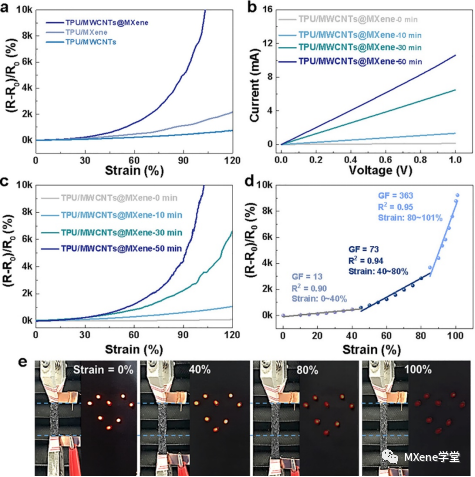
Figure 5: The performance of TPU/MWCNTs@MXene foam as a strain sensor.
TPU/MWCNTs@MXene foam sensor shows excellent performance. At 10%, 20%, and 50% strain, the sensor showed a stable response (Figure 6a). These results indicate that the sensor can be used to detect various strains with high repeatability. When the maximum strain is controlled at 10%, the sensor can show stable cycle performance at a frequency of 0.1-2 Hz (Figure 6b). And showed high cycle stability under strains of 5% to 15% (Figure 6c). In addition, the sensor has excellent long-term cycle stability. Almost no change in the relative resistance of the sensor was observed after 200 cycles/2000 seconds (Figure 6d).
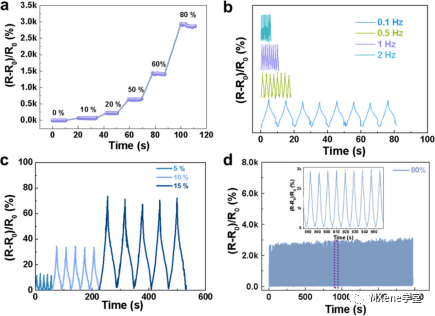
Figure 6: Performance of TPU/MWCNTs@MXene foam strain sensor.
The morphological changes of TPU/MWCNTs@MXene foam under the condition of tensile strain from 0% to 100% were detected by scanning electron microscopy to study the sensing mechanism (Figure 8). The experimental results show that the high performance of the TPU/MWCNTs@MXene foam strain sensor is attributable to the synergistic effect of the interconnected MWCNT permeable network embedded in the TPU foam and the deformable MXene sheet adsorbed on the network. With a smaller tensile strain, the pore size becomes larger, and the increase in electrical resistance is mainly due to the deformation and sliding of the MXene sheet. Under larger tensile strains, the pores become larger and many cracks appear on the surface of the material; therefore, the MWCNTs network will undergo larger deformations, resulting in a rapid increase in sensor resistance. When the tensile strain is very large, both the MXene sheet and the MWCNT network will deform significantly, resulting in a sharp increase in resistance.
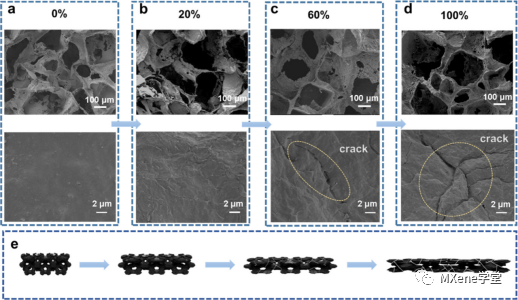
Figure 7 SEM images and schematic diagrams of TPU/MWCNTs@MXene foam under different strains. (a-d) SEM images of foam at 0%, 20%, 60% and 100% strain. The upper image is a magnification of the lower image. (e) Schematic diagram of the evolution of the conductive network during the stretching process.
Figure 8 further shows the application of TPU/MWCNTs@MXene foam strain sensor in gesture detection. Five independent sensors are connected to the five finger parts of the glove to detect the bending and tilting of the human finger. In the first 5 seconds, all fingers are fully extended, so there is no significant change in resistance. Then, the index finger, middle finger and ring finger curl up, causing the resistance of the corresponding sensor to increase rapidly. Subsequently, other gestures appeared, and all the sensors attached to the curled fingers showed an increase in resistance. When all five fingers are straightened again, the resistance of the five sensors is restored, proving the repeatability of the sensors. Therefore, the sensor can be used to detect finger gestures, which has great potential in sign language translation, gesture-controlled robotics, and other virtual reality applications.
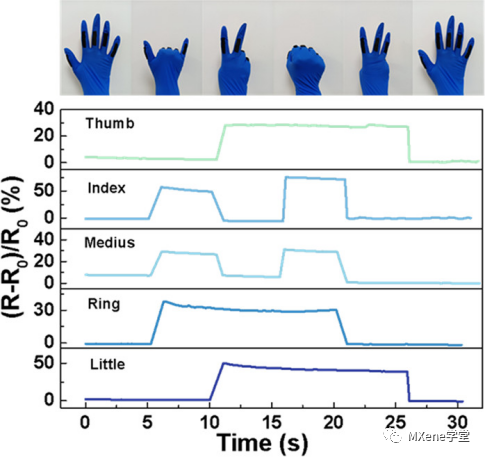
Figure 8 Application of TPU/MWCNTs@MXene foam strain sensor in gesture recognition.
Article conclusion
The author prepared TPU/MWCNTs@MXene foam through a simple and cost-effective method, and successfully used it as a strain sensor. The strain sensor has a GF value of up to 363 and a working strain range of up to 100%. In addition, the strain sensor also exhibits excellent cycle stability under repeated stress cycles. At the same time, the author also demonstrated the application of strain sensors in monitoring human movement, such as finger bending, shoulder bending, knee bending, mouth opening, and throat vibration. In addition, lightweight foam has breathability close to the skin, proving the great potential of foam in wearable electronic products. This information is from the Internet for academic exchanges. If there is any infringement, please contact us and delete it immediately
This information is from the Internet for academic exchange only. if there is any infringement, please contact us to delete it immediately.

| Reminder: Beijing Beike New Material Technology Co., Ltd. supplies products only for scientific research, not for humans |
| All rights reserved © 2019 beijing beike new material Technology Co., Ltd 京ICP备16054715-2号 |